GES032 - Ranelagh CSO
Through London run several rivers, that flow into the Thames. They were covered over mostly in the 19th Century and incorporated into the London sewer system. Although before this they were used as unofficial sewers, causing cholera and other un-pleasant diseases. Sir Josepth Bazalgette mapped out the system in the 1850s and introduced interceptors. This consists of the Rivers running to the Thames, and meeting interceptors, that carry the waste east to Beckton and Crossness for processing.
The rivers Westbourne, Tyburn and Fleet are the best known of these rivers on the Northern side of the Thames, and they all have their origins on Hampstead Heath, their source. The River Westbourne runs from Heath Pond, through West Hampstead, Fortune Green, Maida Vale, Westbourne Grove, Hyde Park, Belgravia and into the Thames at Chelsea Embankment (150m upstream from Chelsea Bridge).
It should be noted that the above Rivers courses are followed, not the actual Rivers. The Rivers are swallowed up by interceptors North of Regent's Park (Middle I No.2).
I've wanted to go draining for ages after seeing the sights the likes of Zero and JonDoe69 had captured, both major drainers. Despite it's size, London doesn't really have many explorers, and of those it does have, even less are willing to step into the pooh. Unlike above ground exploring which i'll happily do solo, it's just not clever to go solo in drains.
Trip 1
I'd been talking about tackling the Rivers with Gringz, and we decided to give it a go. Kev came along as well. We met not far from the Source, my thinking being that there might be walk able tunnels at this point, as they'd need to be maintained. We found a suitable drain lid and Kev had a look, but it was a crawl only pipe, which wasn't suitable. We walked on down to West Hampstead station, only finding one more lid, that wasn't easy access. It was interesting walking down the Ranelagh Sewer from above, but a bit disappointing not getting our feet wet. From other drainers (the collective term for those that venture down sewers), it's quite common to spend some time looking for the right lid.
Trip 2
For our second trip we'd decided to start looking around the Northern end of Hyde Park where we knew there was access. The following week, and waiting for a dry day, I met up with Gringz and and we looked around for a lid that we'd seen on a blog by Brad. It wasn't long before we found what we were looking for. This being our first time down, we checked we could open the lid from below, and then continued down into the slimey, misty sewer. After climbing off the 3m ladder down from the surface, a narrow short flight of steps lead down into a squarish sided circular handsomely bricked tunnel. The Ranelagh Sewer Storm Relief, designed to take overflow in heavy rain.

We could hear water rushing from one direction, so we went to look. A fast flowing stream of water over wellie height in a lowish tunnel flowed past, and another stream fed into it. The water was too fast and too deep for us, so we walked the other way. Popping up to the odd hatch, sometimes up huge long ladders, we plotted our progress roughly south and around the Serpentine to the southern end of the park. We saw a handful of rats here and there, curious about us as we were of them.
We could hear water rushing in the near distance, but before that we finally found another side exit similar to the one we'd descended down, and Gringz climbed up for a look. The lid opened in the park amongst some trees, so we both popped out for a rest and for Gringz to 'ave a fag.
Rested and back's stretched, it's not easy being 6'4" and doing this, and it was back down into the drain. We walked about 10m and found the sewer pipe sloping down to the Ranelagh Sewer below.

The river had some pace to it, and we carefully manoeuvred down the slope to see what was going on. Upstream there was a side pipe with a modest trickle, and next to it the main Ranelagh Sewer shooting down the tunnel. There had been some small amount of drizzle, which might explain the flow, or maybe it was like this all the time.

We tried to stand in it, but not far from the edges it was threatening the tops of our wellies, so we retreated. A look downstream led off into the gloom. (Pic 4)

We came back out again of the lid we'd just gone down, and went in search of a pint and discussions about waders.
Even though dry for two days, was higher than before.
Trip 4!
Carrying a set of Century Super Safety 4000 chest waders around is not the easiest of things. They're heavy and cumbersome. I turned up feeling slightly anxious about putting them on and wearing them in public. Kev had arrived at the wrong location, so turned up a few minutes late. More time to contemplate what was ahead. Kev turned up, his waders ludicrously around his ankles. A group of 3 young-ish people were sat near our entrance in Hyde Park, and were somewhat bemused, as professionally as we could muster, we went down into the Ranelagh Sewer storm relief, which joins the main Ranelagh Sewer.
I went to check the flow, and it was pretty much at the maximum for safe draining. Although in retrospect, it was too high for safe exploring, as any sudden increase in flow would have made progress really tough. There is a line along the wall that shows this maximum safe limit. You can see it in the last picture from Trip 2, about 2 bricks above the water line, it changes from dark brick to orange brick.
I went back up the hole to Kev and got my bag, and we both descended. I was glad to be underground and away from people staring at me as more of a weirdo than usual. We wanted to go upstream, as we were looking for a suitable hatch north of Hyde Park, to allow more exploring upstream. It was heavy going, and was basically one long pipe from where we entered to where we exited. This was the Ranelagh Sewer Main Line, an 8ft high tunnel with decent flow. Lifting our legs you could feel the force, and it wasn't long before my calves were screaming. Kev seemed okay, apart from the fact with this amount of flow, his thigh waders weren't coping very well, and I could see the water splashing his bum as the water splashed around with each step. The water if still, would come to the top of a traditional size 11 wellie.
After what felt like 5 minutes, but must have been nearer 20 minutes, we saw a welcome recess in the wall, and some stairs going up from the main pipe. Scarily there were height markers all the way up to the lid. Kev popped the lid and reported we were near some deckchair sellers. I popped up for a quick look as well, but it was a bit public being near the Serpentine. So we went back down. It was sweaty and hot in the sewer, as well as hard work so I was glad of some fresh air.
Back in the sewer Kev took the lead, and we pressed on. A mist basically sits atop the water about 5m ahead of you, making seeing further ahead troublesome. A 200lumin torch only goes about 15m-20m max, an even then it's a squint.
We popped up again in the next recess stairs, roughly 200m since the last, and I was facing some bushes. As Kev and I climbed out, 2 early twenty some-thing's engaged us in conversation "have you come from France?" my response in French confirmed his curiosity. We explained we were engineers carrying out work. Amused they left us to gasp some good air, and return down. People think the smell down there is going to be awful, but it really wasn't. It's a sort of very mild washing up liquid type smell. Although we were walking in a 'clean stretch' of the sewer. There are very few flushing toilets in Hyde Park.
We pressed on, and I was certainly starting to suffer a bit. Some background might be useful to explain why I was suffering. I'd been roped into helping a mate do a charity football marathon on Saturday. So I had played 7 hours of football, with a break here and there. On Sunday I had ridden around central London looking up the lids needed for the rest of the R Sewer and the KSP Sewer. So I was muscularly weak from that. The next set of stairs lead up to a good lid, and I popped my head up for a quick reccie, and down again.
We kept going at a fairly regular pace, my longer legs meant having to wait for Kev every now and again. I welcomed the breaks. The next set of stairs were different to the others. They were curved like a turret in a castle, or church tower stairs. They had small narrow slit windows in the central small column the stairs swung around. Halfway up the walls were covered in limestone, the kind that stalactites are made of. Kev tried the lid, but it wouldn't budge. So back down the spiral stairs we went, annoying a small rat we'd met at the top. I remained curious about where that lid would have come out, as it went higher than ground level.
Pressing on we could hear a roar of water in the distance, and we heard it for ages with no sign of anything. We passed a metal ladder dropping straight into the centre of the stream, that lead to what would be a sealed manhole. Again we pressed on. By now I was starting to misplace my feet a few times, and Kev had water that was in his waders. We were ready to get out. Quite some way, without finding any more escape hatches, we kept plodding on. The sound of rushing water still somewhere ahead in the murky gloom.
Eventually my torch picked out a split in the tunnel approaching, and the roar of water got considerably louder. My torch then picked out 3 arches and a trough above them. This was the (southern) Mid Level Interceptor No.1. Interceptors run West to East and carry the bad stuff away down to Beckton on the North side of the Thames, and Crossness on the South Bank. They have brown water, smell bad, and are to be avoided. I could see some rungs up the side of the middle arch, but water was flowing over the edge of the interceptor, making it some what hazardous. Not having encountered an interceptor before, I went precariously for a closer look. I clutched greedily at the metal rungs when I got close, and climbed up to the top. Before me was the stone trough with a brown fast flowing stream carrying Londoners poop away. A ladder rose up here to what i'm guessing was a manhole, I couldn't quite see from the angle. I then carefully lowered myself down the rungs, and back into the overflow from the interceptor. It was somewhat precarious, and I was a little worried at the stepping off point back into the main tunnel.
I eventually made it, and then joined Kev in going downstream 5m or so to the side tunnel we'd seen earlier. It was easier for sure going downstream, but the flow pushed fairly hard against each step you went to put down, making it quite precarious. The water in the side tunnel appeared still, and the tunnel height was about 5ft. We only needed to go another 5m to a set of stairs that lead up to North of Hyde Park, where we quickly exited. We walked back into the Park and laid on the grass, exhausted. Kev emptying the water from his waders. Me emerging drenched in sweat from my chest waders. Military fitness, nah, sewer fitness is what you need to get those strong leg muscles going and lose weight!
Things we learnt on this trip.
*You can't do a whole river in one go. A section at a time is how to do it.
*When you meet an interceptor, your trip normally ends and you will likely need to get out to go to the next section.
*Interceptors are rather scary beasts, they rise above you as you approach, smell, and are very loud. They have the ability to seriously overflow without warning.
*It's best to go wading at night, as there are less washing machines, toilet flushes etc to increase the flow.
Trip 5
Our little trio in various sizes and combos, had used the Ranelagh Sewer for training. Completing the R Sewer wasn't high on our list, because we wanted to find new drains. Hence our trips down the Stamford Brook Sewer (see relevant post). And so it was that after some time away, we returned to explore the well trodden path of the R Sewer.
A quick prayer to Cloacina, and Kev & I popped down. We were at the southern end of Hyde Park, and turned left to head down stream (see Pic #4).The tunnel lead off and it wasn't long before we could see something blocking the way from the side. It had a load of arches and small girder supports across it. As we got closer the narrowness of the sewer path made things a little tricky. We looked down, and got a glimpse of what I believe to be the R Sewer relief (or 'The Egg' in drainer speak). Why The Egg? Look here!

I waddled on down to where Kev is sat in the above pic, and took a shot looking upstream. The lovely yellow and red bricks meeting here.
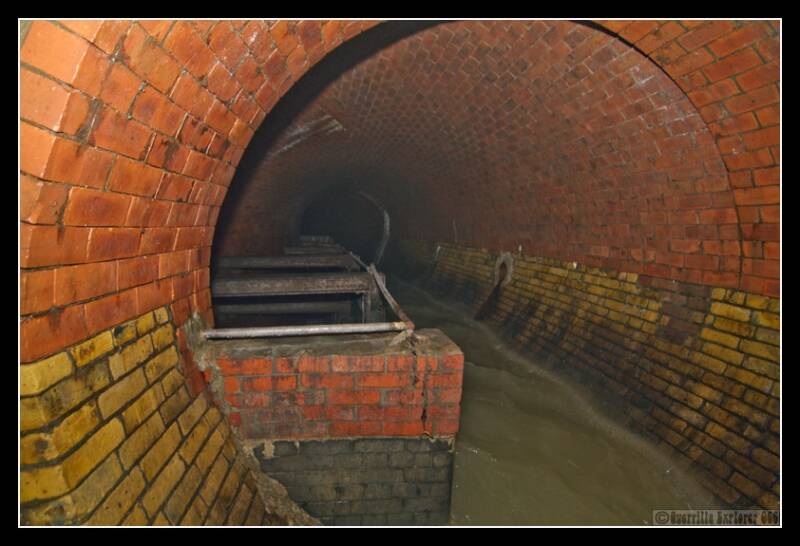
At this point it was clear that the batteries in my P7 torch were finally fading, and I needed new ones. Sadly, it seems that for an unknown reason, my torch didn't like new batteries, and died. Worryingly I realised I'd left my back-up torch at home, and was left with a Petzl head torch. Kev meanwhile had re-entered the flow and investigated a side tunnel.

Most of my shots aren't great, due to using my Speedlite 430ex. It only really covers up to about 8m if you're lucky.
We plodded on, and started to hear the roar ahead of an interceptor. It can be, not frightening, but leave one a little on edge approaching it. Mainly because you've no idea what to expect. The noise fires around the brick tunnels, making something quite small seem huge.
At the interceptor, the flow lurched off to the left and down a passage into the gloom. Beside it was a long wooden plank set to divert the flow. The other side was a nasty dark looking stercoraceous trickle in a 10ft/3m high tunnel. Eagerly we stepped over into the minimal flow. I'd seen so many pictures of the R Sewer as a trickle, but we always seemed to be unlucky. So it was nice to stroll on. There were loads of little side pipes and mini-eggs as we paced on. Slightly worryingly most side ladders were manhole covers and split covers. No good for surfacing in case of trouble.
We came across a side exit that looked different from any other. It was modern concrete and square. We went to investigate. It wasn't something I was expecting to find, as it was long horizontal tube that went down a good 20m.

There were 4 or 5 levels down, with a long ladder between them all, and a safety hatch on each level. I didn't think there was much to see going down, but Kev was keen. So off he went into the darkness below. I was concerned about torchlife, so turned off my head torch and watched his light bouncing around the tube as he descended. Every time I thought he'd reached the bottom level, it seemed there was still more to come. When he did reach the bottom, he couldn't go into the water as it was too deep. So he then had to climb all the way back up, making noises from the exertion of climbing and the disappointment and not finding anything.
It was then back into the sewer through the concrete opening.

We walked on, and the flow had started to pick up a bit and was now brushing our ankles. In the distance we heard more charging water. As we got up to it, it was just a busy side pipe, about 15cms high. Above it was a huge silver flap, that could seal the round ring in the tube. It was fixed to the ceiling at this point, so I nervously went off to see what lay ahead. A side exit lead to a manhole cover. And then the sewer had a round metal section for about 10m, before becoming a regular sewer. I didn't go much further when I saw another flap in the sewer. This one was older and heavier looking. I gave it a gentle shoulder barge, and nothing was happening.
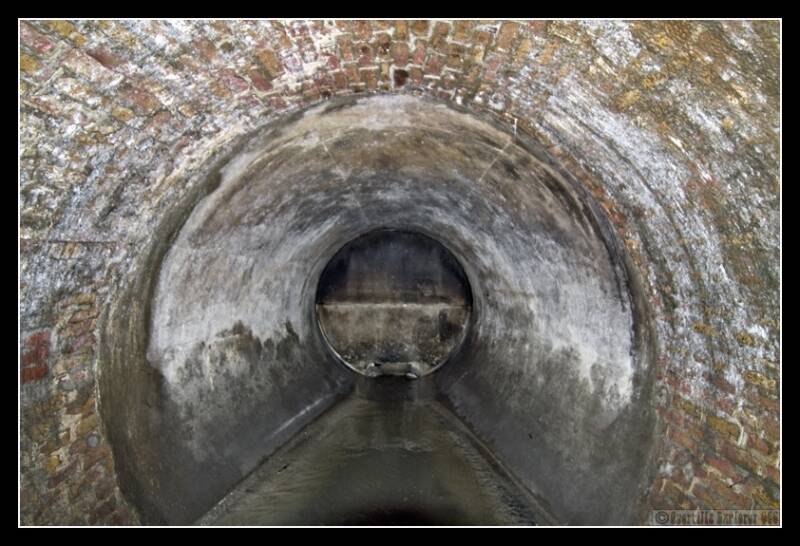
So I walked back up to the open flap. Kev took a few light painting pics, and then we back tracked 25m to the only easy lift we'd see since near the Egg junction. I popped the lid and after a nervous look around, recognised we were just north of Sloane Square. A group of Sloanes were chatting and braying loudly just around the corner, luckily out of site.
TRIP 6 - Serpentine to Sloane Square
Back to Knightsbridge again and we were surprised by the low flow of the CSO. Most other trips had seen this stretch with strong flow. I took advantage of the situation and went up the passage on the left (with Kev stood in).

The bricks were white and well worn here, this is looking down the 25m tunnel down to the junction above.
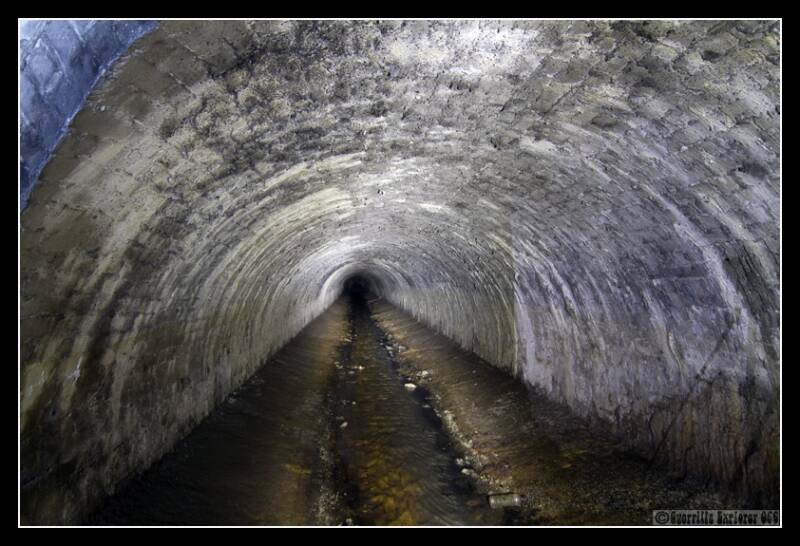
On exiting the above tunnel we emerged into a large chamber with various irregular chambers at the far end. The chambers back onto the Serpentine, for this is the Serpentine overflow. When the Serpentine fills to a certain limit, this system prevents the Serpentine from flooding into Hyde Park.

Gringz and Kev are both fans of lighting and silhouette underground, this is a shot they set up, Gringz using one of his trademark poses on the left!

Inside one of the chambers of the overflow, the otherside of the grill is the Serpentine.

Another attempt to light the chamber in an interesting way. I added my P7 torch to the mix.

Walking back into the 3 junction chamber, behind the camera is the Serpentine overflow tunnel and chamber. More lazy flashgun shots i'm afraid.
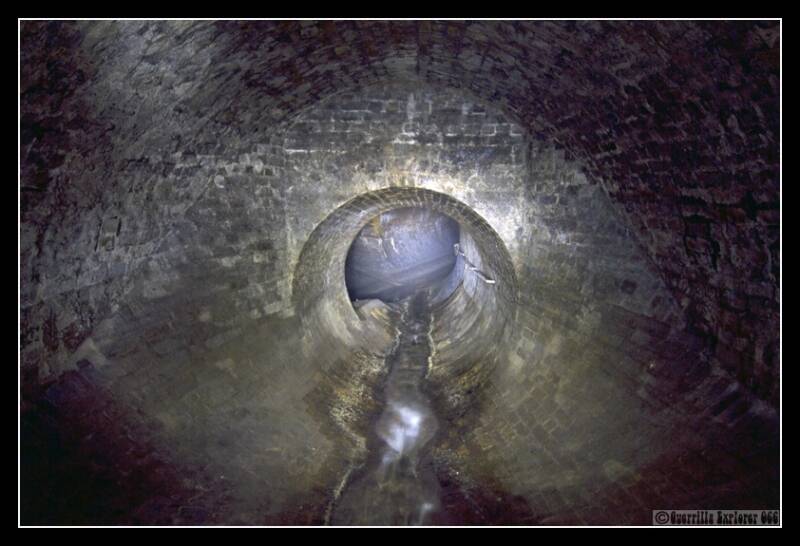
Looking up into the Ranelagh Storm Relief as it heads north under Hyde Park.

This stretch is usually rather precarious as the water is squeezed into a smaller channel, but today it was a breeze. The wall keeps the flow from dropping into the Ranelagh Storm Relief down below, except in times of flooding.
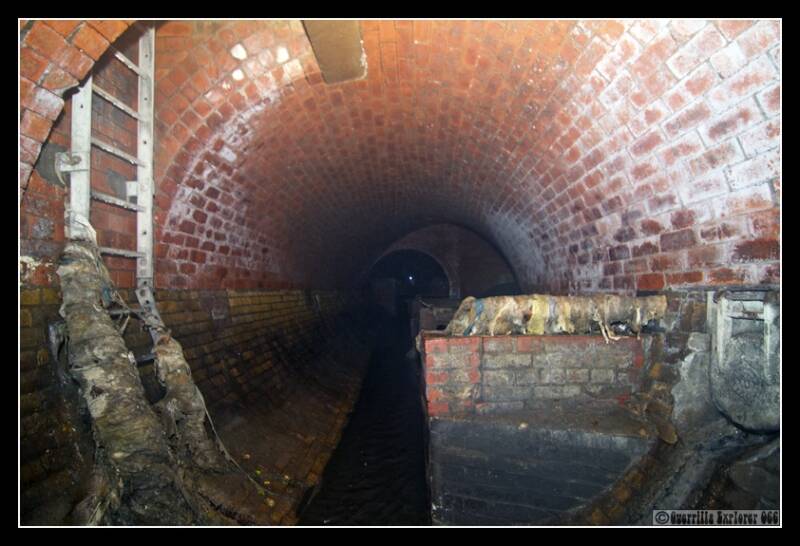
Kev stands on a bridge at the Ranelagh Storm Relief junction. The yellow bricks filling the lower section of the tunnel, one presumes because they are harder wearing than the red bricks above which show more wear. I guess workers can lower the wooden weir boards down, to divert the flow into the storm relief below (the wooden boards at the base of the ladder).
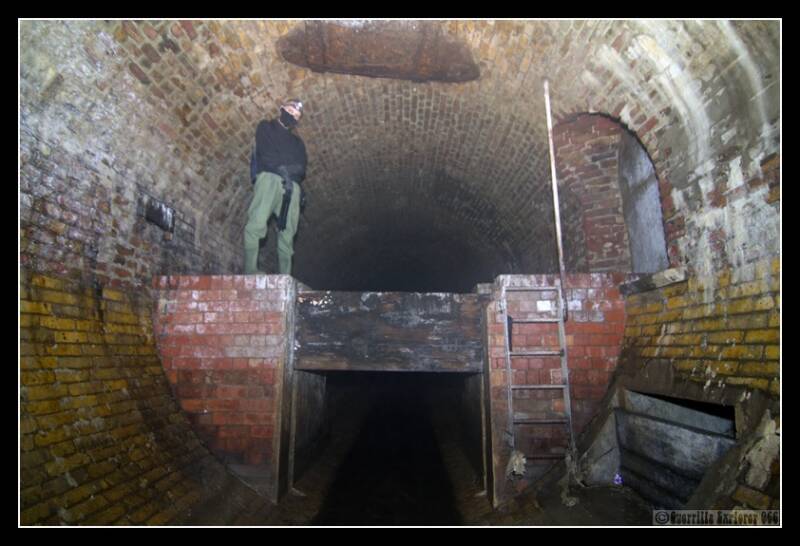
Another flood chamber, a large cylindrical chamber that drops several stories down. I've yet to truly understand how these work. This time Kev descended the depths to find yet again, nothing other than a pond of stagnant water.

The shallow sides of the tunnel as it has a concrete base here, showing it's been modified since Victorian times.

Part of the remodelling of this section of the Ranelagh CSO, with large amounts of concrete used, and a hefty steel door included in the design. Allowing the next section of CSO to be shut off for maintenance and flow control.

Closer shot of the door, I can admit to be a little apprehensive walking underneath the door. As we didn't know if it was controlled locally or at some TW site elsewhere. We also didn't know if there was a side exit for us to get out from, so could potentially end up trapped in a section of the CSO.

Ever the adventurous, we pushed on into the next section and luckily there were some side exits that were useable. However we came to a large round very heavy steel flap. It was time to exit into the shadows next to a a building near Sloane Sq. According to legend, the Ranelagh CSO flows over Sloane Sq tube station, but we never found this to be the case. In Trip 7 we were able to walk up to the other side of the flap we couldn't pass. So unless there's a side sewer that flows over the tube station and joins the Ranelagh CSO, I can't confirm what is in the square metal tube that passes over the station.
TRIP 7 - Westbourne End
With no lids in the area near Sloane Sq south we could use, we had to go down the road a 100m or so, and walk back. Eventually we came to the large metal flap we'd encountered before which sits in a RCP (Round Concrete Pipe)

The chamber continues on getting larger as it heads to the Thames, this passes under Ranelagh Gardens in Chelsea, from whence it gets it's name.
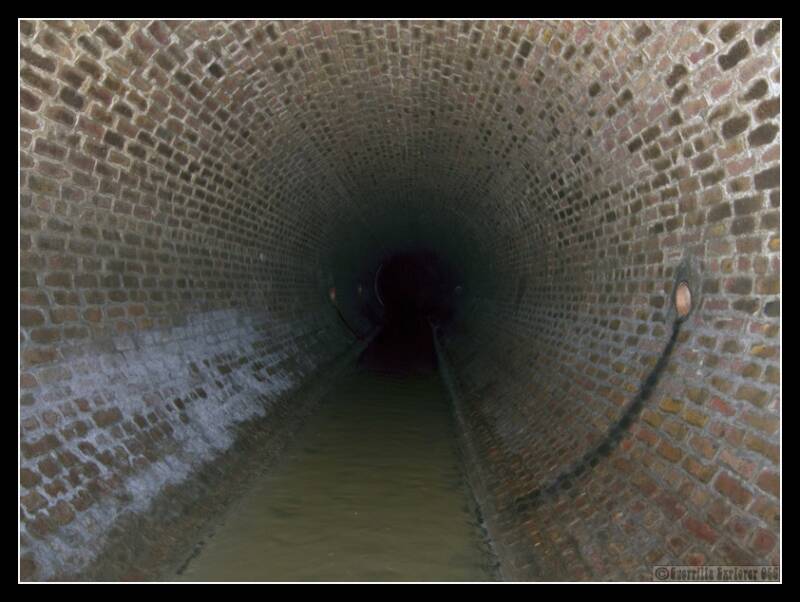
I found an intriguing side pipe, and went off to investigate, crawling and scampering through all kinds of nastiness. This small tunnel had a mix of yellow and red bricks mish mashed together. As i moved slowly through it, more and more bits had cave in and the roof looking fragile, so I decided it'd be best to give it a miss. I did find a lid, however it was locked. Not much use in an emergency.

Eventually we came to a roaring sound, which usually indicates an interceptor, and this time wasn't any different. As the tunnels reverberated with the thrashing sound of water disappearing into the low level interceptor, we came across the end of the Ranelagh CSO. Metal chains stripped across the round tunnel to act as a safety method for any poor soul getting washed towards doom. The detritus that gets flushed down the toilet finding new homes on the chains. The condensation got to the camera at this point. Rather than some overkill blurring to obscure the identity of a fellow drainer.
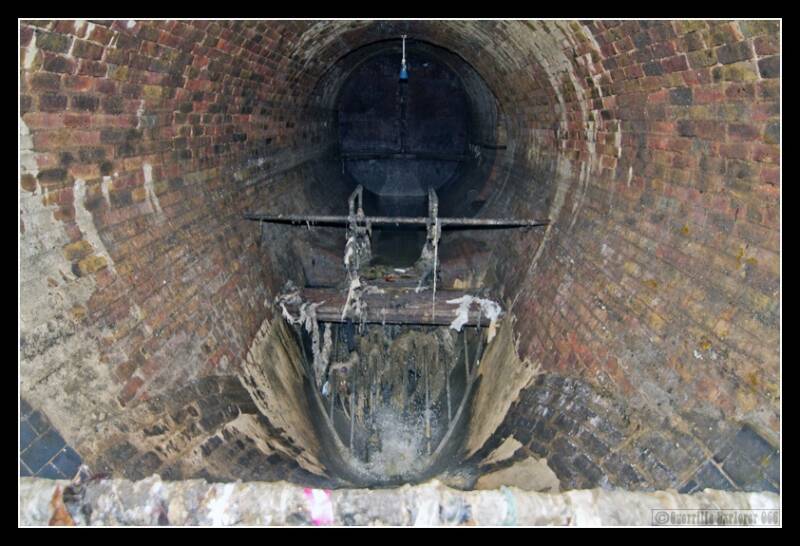
Kev sets up his camera for some more great shots of his.

Like the sand monster in Return of the Jedi, the low level interceptor sucks up all that is flowed into it. Sadly this included my P7 torch, which i accidentally dropped and watched helplessly sail off into the brown fresh and off down to the East End. It's light still shining as if a cry for help.
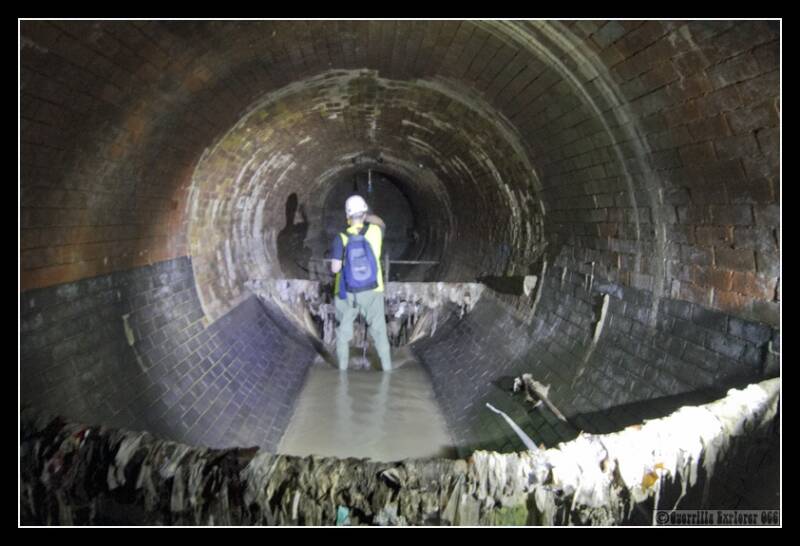
Our attention now turned to North of Hyde Park, and the upstream section. However that wouldn't be for some time.
TRIP 8 - Ranelagh Upper
Before finding a suitable map, i'd looked around the area of North of Hyde Park based on various 'old rivers of London' styled maps and books, and hadn't found a suitable lid. With a good map in my hand, finding a lid turned out to be no problem. Annoying when you look so close, but end up missing it.
On descending the steps, we found ourselves in a different type of pipe. The main CSO chamber had a curve-bottomed hemispherical chamber above it. With no obvious purpose other than being structural. Kev just visible in the mainline pipe, and the upper hemispherical chamber.

Looking down the hemispherical chamber running above the Ranelagh CSO.

Looking up the steps to the ladder we'd descended from the surface world. On the right wall are white measurement scales.

I was keen to see how the pipe ends and it's connection to the Low Level Interceptor. As we progressed the going underneath became very hilly. Sediment had built up in the slow flowing section of the Ranelagh CSO. Being the only one in the group with chest waders, I gingerly moved forward as the depth increased over my knees. The sediment on the bottom would increase in height and then a soft patch would see one sink lower. The other two had waist waders on, but Kev had a hole at groin height. I was concerned about going on, and set about trying to get a shot. However the condensation was bad in this area, and this was the best I could get with a flashgun. Looking upstream. Over the weir on the left was a lower muddy area a metre and a half or so below, that lead to a pipe entrance below where the photo was taken.
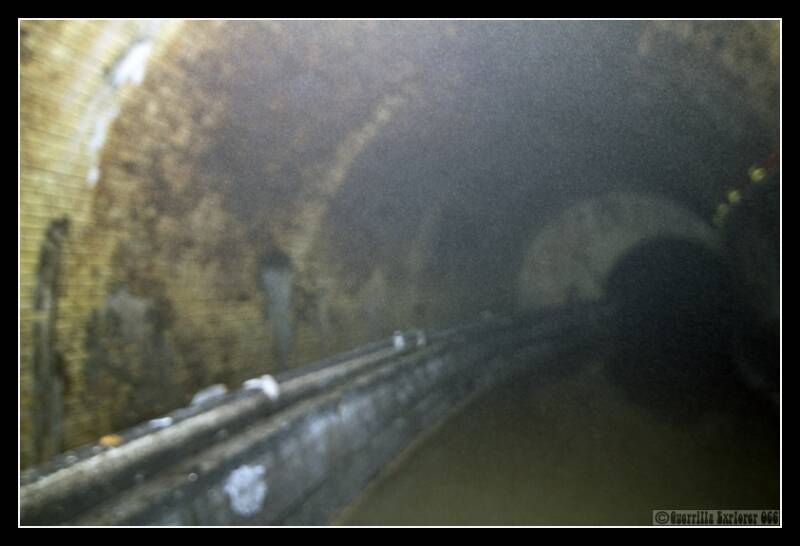
Looking North/upstream, the metal railings on the left of the larger pipe are above the pipe the weir feeds into, mentioned in the last pic. Another pipe joins the chamber on the left. The smell in the air was becoming awful, and with no gas-detectors I was becoming concerned. However the other two were a good 20m ahead of me at another feature.

This was another weir section with 3 distinct arches, that lead down into a lower chamber.
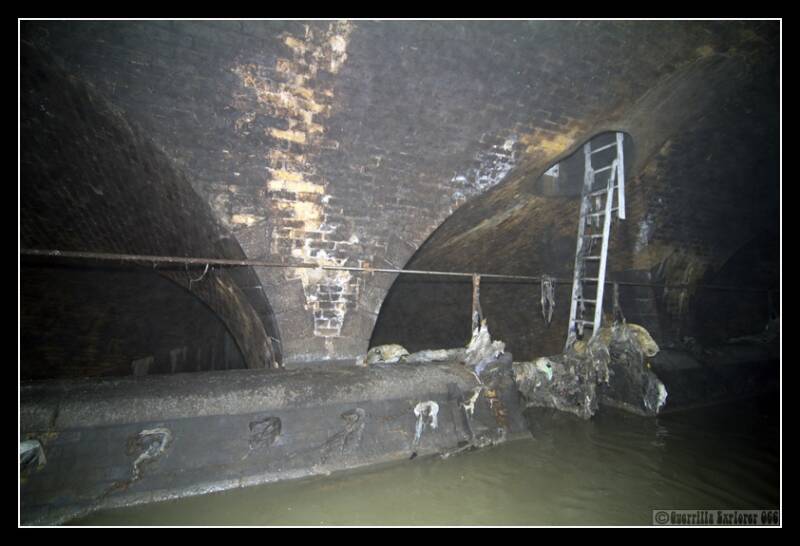
Looking down the Easterly of the 3 arches. I began to recognise it as the Interceptor overflow that i'd previously been somewhat terrified of as my first encounter with an interceptor. On my first meeting with the interceptor here, it had been overflowing down into the Ranelagh CSO pipe under the Park. Now it was gentle and placid even, and left the pipe under the Park with little more than a trickle in.

As for the pipe we were in, it disappeared down this funnel to join the Interceptor presumably below. Again, making an assumption, I would guess the funnel was necessary to increase the speed of the flow, as the interceptor heads down to Beckton.

We hopped (it wasn't as graceful as that in reality) over the weir's wall, and down some steps. Grabbing a few shots of the three sub-chambers.

A bit further down the pipe under the Park and Kev working on a shot. A smaller pipe on the left, from where one can escape this subterranean world.

Looking south down the tunnel as it goes under Hyde Park
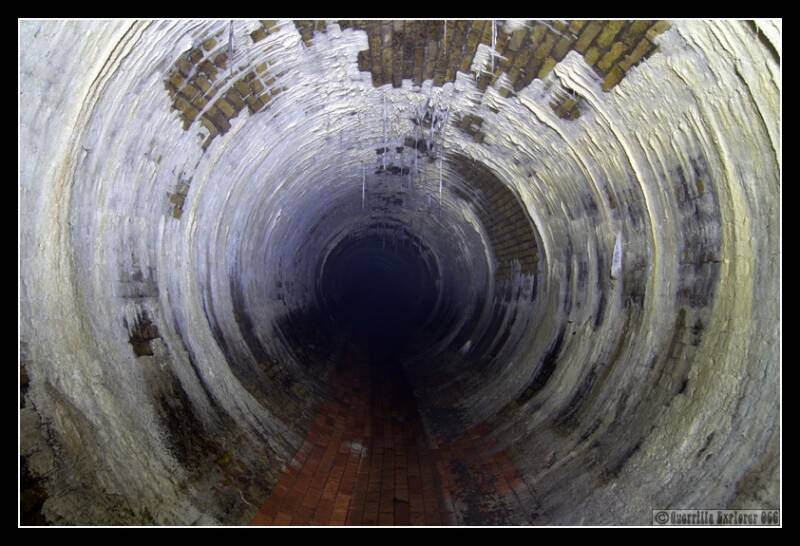
The main weir section, the Ranelagh CSO running above it.
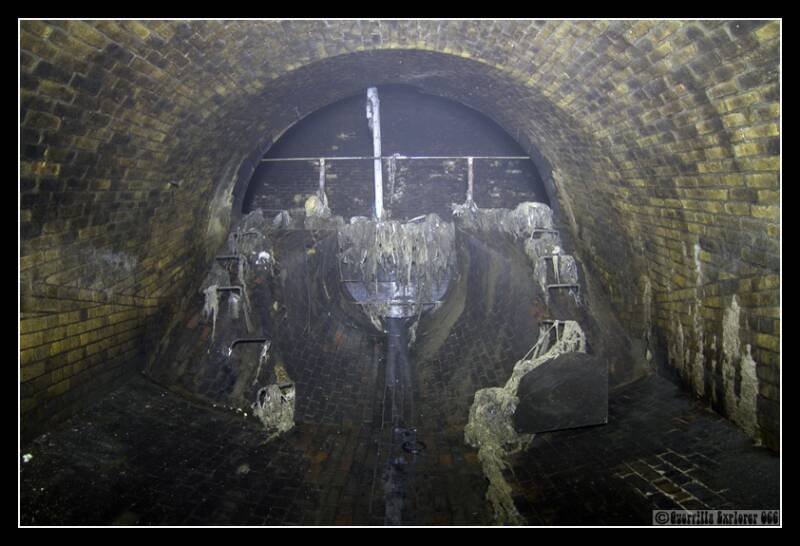
We climbed back up the weir section, and headed North and upstream in the Ranelagh CSO. The going was mixed. It was fairly heavy flow, hitting the top of a pair of regular wellies, should one be foolish enough to wear such footwear in here. The going was also slippy most of the time. Mainly due to the amount of washing machine outflow that was chasing down the pipe. We could hear a roaring ahead, and it wasn't long before we past two smaller sewers flowing into the mainline pipe. Just beyond that was a slide down from an upper level.

The slide had steps on the side, enabling us to easily pass to the next level. No precarious attempts to get up the slide.

Gringz and Kev climb up the steps beside the slide.

A smaller sewer enters, and just after that a side exit. The flow may look deep, but it was actually shallow and rather wide. There was a small dip in the middle of the chamber, and slippy sides, so it was tough going.

We reached another side exit, and also a point where the roof height lowered to a point where we'd have to duck our heads to go on, or at least I certainly would. I wanted to go on a bit further, but the other two were keen to call it a night. We went up the side exit that exists at this point. Just as Kev was about to push the lid, we caught the screams of a police car coming by. It didn't stop, and Kev popped the lid. As tumbled out into the late evening light. This was the exit we took, with lots of plant life on the sides.

I hope to keep going up the Ranelagh CSO until it meets a storm relief, or becomes a cramped crawl. We'll see, as London has a lot of distractions.
TRIP 9
As part of a project organised by JonDoe69, a foursome of seasoned drainers were attempting to move between various drainage networks. As part of that we ended up at a junction with the NW Storm Relief, and walked down to Hyde Park. I saw walked, we had a dinghy, and took turns to sail down to Hyde Park, and down to The Egg (Storm Relief) junction.
TRIP 10 - Upper Ranelagh towards source
Intrigued by the trip into the Ranelagh in Trip 9, I was keen to return. I walked up the NW Storm Relief (See GE197 - Currently unpublished) with Residues and Eric Ruggerio, the latter over from New York. We walked from Notting Hill up to here in Kilburn, where the Ranelagh and NW Storm Relief meet for the second time. They meet again further North. This is looking down the main pipe South.

Turning around from the shot above, and looking upstream, this is the weir from the Ranelagh into the NW Storm Relief below. The Ranelagh from source in Hampstead Heath to Hyde Park has a steep flow, and walking upstream is tricky to say the least.

With the weir behind the camera, this is the ladder down to one of the two overflows into the NWSR. The other is down some steps. The shallow sides of the tunnel as it has a concrete base here, showing stairs on the left of the picture. It's not only impressive that the funghi clings to the walls down here, but that it manages to survive the odd heavy downpour when this place must be awash with crazy amounts of water.

To the left of the shot above, this was taken on the weir, looking down into the tunnel that acts as a spur to the NWSR.

TRIP 11
I intended to walk up the NWSR and return back downstream in the Ranelagh to the junction seen above in Trip 10. Unfortunately the local Water company had changed the lids, and we couldn't open them. So our plans changed. Instead we had to walk upstream in the Ranelagh, not something I was keen on, as mentioned above, the flow here is pretty fearsome as sewers go. Residues and I slowly walked up the passage, holding onto the sides and ceiling for stability. It wasn't long before we came to a junction with a branch that comes in from Brondesbury. This is it on the left. The ceiling here is reinforced, because we are near or underneath the Jubilee Underground line above.

The approach to the junction with the NWSR, white funghi lines the pipe wall. This is looking downstream.

Turning 180 degrees from the above pic, this shows the complex junction here. Up the pipe on the right of the picture, a weir can be just made out in the darkness. On the other side of the weir and to the right, is an overflow down into the NWSR. This junction represents the 'source' of the NWSR. My map shows there are 2 streams that meet here, however, as you may have noticed, there are 3 pipes that join here, with the NWSR a level below. More exploring is needed to work out what comes from where.

Next to the drop shaft into the NWSR, is a ladder up two levels. This is looking down into the pipe that sends water cascading down the stairs in the photo above. The passage off to the immediate right of the camera leads to a ladder down to the pipe at the base of the stairs in this photo. An odd arrangement, but I'm sure there's a reason.

Looking down from the top of the stairs, only about 5cms of flow, but when thrown down some stairs looks rather dramatic. Wearing only thigh waders, I didn't contemplate walking through the torrent of water at the base of these stairs.

Behind the pic above, the water approaches seemingly sedately. This appears to be the main flow of the Ranelagh, looking upstream.
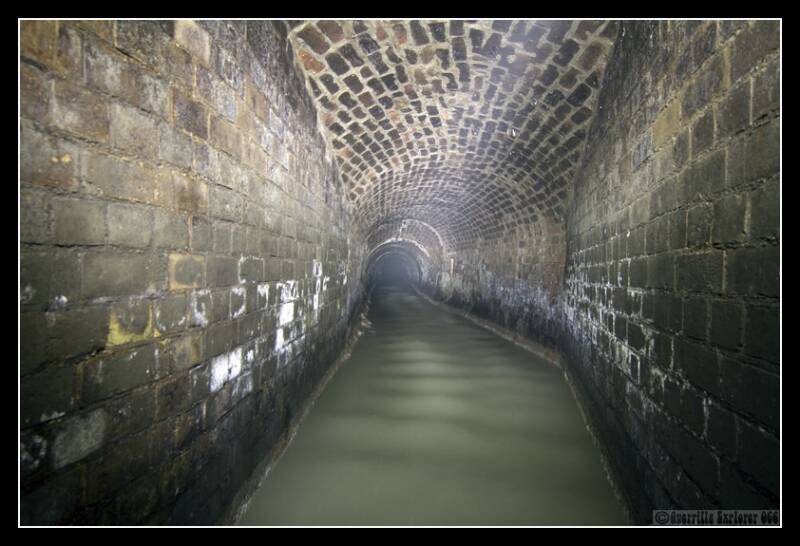
Yet more trips are needed to sort out where the pipes go, although with the pipe/tunnel height shrinking, it becomes less attractive a proposition.
Add comment
Comments